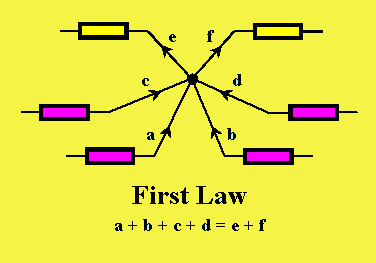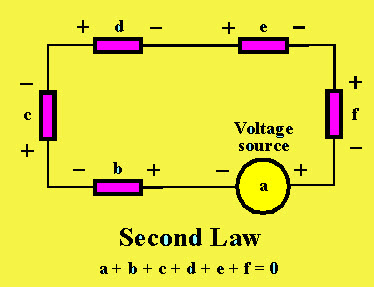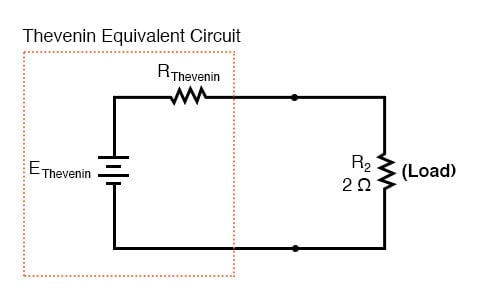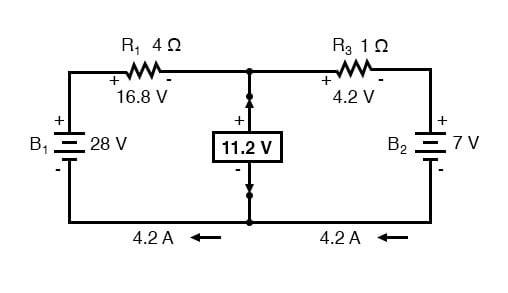A Brief Explanation on How Kirchhoff’s Laws Working
In the year 1845, Gustav Kirchhoff (German physicist) introduces a set of laws which deal with current and voltage in the electrical circuits. The Kirchhoff’s Laws are generally named as KCL (Kirchhoffs Current Law) and KVL (Kirchhoffs Voltage Law). The KVL states that the algebraic sum of the voltage at node in a closed circuit is equal to zero. The KCL law states that, in a closed circuit, the entering current at node is equal to the current leaving at the node. When we observe in the tutorial of resistors that a single equivalent resistance, (RT) can be found when multiple resistors are connected in series or parallel, these circuits obey Ohm’s law. But, in complex electrical circuits, we cannot use this law to calculate the voltage and current. For these kinds of calculations, we can use KVL and KCL.
Kirchhoff’s laws
Kirchhoff’s laws mainly deal with voltage and current in the electrical circuits. These laws can be understood as results of the Maxwell equations in the low frequency limit. They are perfect for DC and AC circuits at frequencies where the electromagnetic radiation wavelengths are very large when we compare with other circuits.
Kirchhoff Current Law
KCL or Kirchhoffs current law or Kirchhoffs first law states that the total current in a closed circuit, the entering current at node is equal to the current leaving at the node or the algebraic sum of current at node in an electronic circuit is equal to zero.
In the above diagram, the currents are denoted with a,b,c,d and e. According to the KCL law, the entering currents are a,b,c,d and the leaving currents are e and f with negative value. The equation can be written as
a+b+c+d= e + f
Generally in an electrical circuit, the term node refers to a junction or connection of multiple components or elements or current carrying lanes like components and cables. In a closed circuit, the current flow any in or out of a node lane must exist. This law is used to analyze parallel circuits.
Kirchhoff Voltage Law
KVL or Kirchhoff’s voltage law or Kirchhoffs second law states that, the algebraic sum of the voltage in a closed circuit is equal to zero or the algebraic sum of the voltage at node is equal to zero.
This law deals with voltage. For instance, the above circuit is explained. A voltage source ‘a’ is connected with five passive components, namely b, c, d, e, f having voltage differences across them. Arithmetically, the voltage difference between these components add together because these components are connected in series. According to the KVL law, the voltage across the passive components in a circuit is always equal & opposite to the voltage source. Hence, the sum of the voltage differences across all the elements in a circuit is always zero.
a+b+c+d+e+f=0
Common DC Circuit Theory Terms
The common DC circuit consists of various theory terms are
Circuit: A DC circuit is a closed loop conducting lane in which an electrical current flows
Path: A single lane is used to connect the sources or elements
Node: A node is a connection in a circuit where multiple elements are connected together, and it is denoted with a dot.
Branch: a branch is a single or collection of elements which are connected between two nodes like resistors or a source
Loop: A loop in a circuit is a closed path, where no circuit element or node is met more than once.
Mesh: A mesh doesn’t contain any closed path, but it is a single open loop, and it does not contain any components inside a mesh.
Path: A single lane is used to connect the sources or elements
Node: A node is a connection in a circuit where multiple elements are connected together, and it is denoted with a dot.
Branch: a branch is a single or collection of elements which are connected between two nodes like resistors or a source
Loop: A loop in a circuit is a closed path, where no circuit element or node is met more than once.
Mesh: A mesh doesn’t contain any closed path, but it is a single open loop, and it does not contain any components inside a mesh.
Example of Kirchhoff’s Laws
By using this circuit, we can calculate the flowing current in the resistor 40Ω
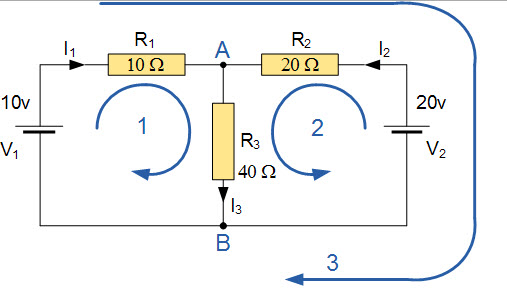
The above circuit consist of two nodes, namely A and B, three branches and two independent loops.
Apply KCL to the above circuit, then we can get the following equations.
At nodes A and B we can get the equations
I1+I2=I2 and I2 =I1+I2
Using KVL, the equations we can get the following equations
From loop1: 10=R1 X I1+R2 X I2= 10I1+40I2
From loop2: 20=R2 X I2+R2 X I3= 20I2+40I3
From loop3: 10-20=10I1-20 I2
From loop2: 20=R2 X I2+R2 X I3= 20I2+40I3
From loop3: 10-20=10I1-20 I2
The equation of I2 can rewrite as
Equation1= 10=10I1+40 (I1+ I2) = 50 I1+40 I2
Equation 2= 20=20I2 +40 (I1+ I2) = 40 I1+60 I2
Equation 2= 20=20I2 +40 (I1+ I2) = 40 I1+60 I2
Now we have two concurrent equations which can be reduced to give the values of I1 and I2
Replacement of I1 in terms of I2 gives the value of I1= -0.143 Amps
Replacement of I2 in terms of I1 gives the value of I2= +0.429 Amps
Replacement of I2 in terms of I1 gives the value of I2= +0.429 Amps
We know the equation of I3 = I1 + I2
The flow of current in resistor R3 is written as -0.143 + 0.429 = 0.286 Amps
The voltage across the resistor R3 is written as: 0.286 x 40 = 11.44 volts
The voltage across the resistor R3 is written as: 0.286 x 40 = 11.44 volts
The –ve sign for ‘I’ is the direction of the flow of current initially preferred was wrong, In fact, the 20 volt battery is charging the 10 volt battery.
This is all about Kirchoff’s laws, which includes KVL and KCL. These laws are used to calculate the current and voltage in a linear circuit, and we can also use loop analysis to calculate the current in each loop. Furthermore, any queries regarding these laws, please give your valuable suggestions by commenting in the comment section below.

